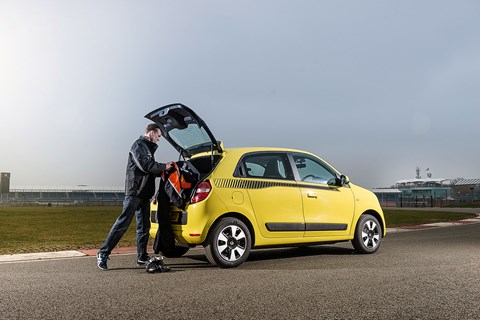► Daily driver diary: living with a Renault Twingo
► Rear-engined, rear-wheel drive, three-pot power
► Roomy interior, tiny boot. Cheaper than a Smart!
Month 13 running a Renault Twingo: time to say goodbye
My dad used to have a Renault Avantime, the weird coupé Espace, and though it was a car with *merits* (I’m being generous for his sake) it was not a big seller. Likewise the Vel Satis luxury saloon that went on sale at the same time. Combined, there are about 700 of them left in the UK. As well as the quirky styling and the questionable market positioning, Renault was also up against a fundamental prejudice in the minds of the British public: French luxury cars. The Germans do luxury; the Brits do luxury; even, arguably, the Italians; but the French? They make cars for peasants, don’t they?
Which is why the Twingo feels so right. Yes, I know the Twingo is a half German car, but there was a good reason Renault teamed up with Smart on this rear-engined five-door hatch, rather than teaming up with Rolls-Royce on a £300k luxury fastback. The Twingo is what Renault has always traditionally done best: a simple, economical city car with real character.
And that’s how we’ve all felt about our yellow bumblebee. Nipping into town for a baguette and a bottle of plonk is a journey that’s written into this car’s genes, with its thrummy three-cylinder engine and its astonishing dog-chasing-tail turning circle. Its interior is well-judged too – pared back and functional on the one hand, yes, but not plain or boring, and sometimes straight forward functionality is what we all crave – like when you just want to get in and connect your iPhone. In this sense, the Twingo has proved to be bang-up-to-date and easy to live with.
Take it further than your local boulangerie or (as we call them in Britain) ‘the bread shop’ and its limitations are exposed. One or two of CAR’s drivers commented on the waywardness of the Twingo at motorway speeds, when – with a nasty sidewind or even in another car’s wake – the Renault feels like it’s not completely tied down to the road. And motorway speeds themselves aren’t easy to maintain, especially if you hit a long uphill slope. Whenever I took the Twingo on a big, cross-country motorway drive, I found my right foot mashing the accelerator to the carpet the whole time, with absolutely nothing left in reserve.
But for me, the Twingo has one fundamental flaw that stops it from being a truly great car – the loose-feeling, finger-light steering that requires you to swirl your arms round and round. There was a reason that the original Mini became a legend, and it wasn’t just because of the clever packaging – it was great to drive too, in a go-kart kind of way. In comparison, the Twingo is easy to drive, yes, but it also feels disconnected, and slow to respond. Shame – if the engineers had been ballsy with a really direct steering rack, it could have been absolutely amazing. But then, Renault tried ‘ballsy’ before, and look where it got them.
Still, we’ll miss the little Renault, and we send it on its way with happy memories
Count the cost
Cost new £10,585 (including £590 of options)
Dealer sale price £6633
Private sale price £6133
Part-exchange price £5738
Cost per mile 12p
Cost per mile including depreciation 76p
Logbook: Renault Twingo Play SCE 70
Engine 999cc 12v 3-cyl, 69bhp @ 6000rpm, 67lb ft @ 2850rpm
Transmission 5-speed manual, rear-wheel drive
Stats 14.5sec 0-62mph, 94mph, 105g/km
Price £9995
As tested £10,585
Miles this month 628
Total miles 7770
Our mpg 42.6
Official mpg 62.8
Fuel costs overall £936.75
Extra costs £0
By Mark Walton
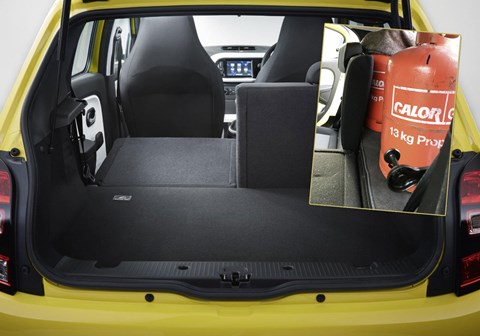
Month 12 running a Renault Twingo: boot size and practicality
Despite its rear-mounted engine and its tiny footprint the Twingo has a pleasing, Renault-4-like utilitarianism.
An example. I had to pick up a pair of 13kg propane canisters (they contain 13kg of product, but gross weight is way more). There wasn’t enough space to stand them up behind the seats, and with the seats down they’d soon have been rolling around like a pissed R2D2.
But there’s a two-position catch for the rear seat backs which lets you secure them in a more upright position, creating more space in the boot, and exactly enough to hold securely two of the big red bottles. Cheap, clever, useful.
By Ben Oliver
Month 11 running a Renault Twingo: Ben Oliver’s verdict
I swapped our biggest long-termer for our smallest: my Range Rover Sport for our Renault Twingo. At first I loved it: loved the looks, the thrum of the three-pot, the postage-stamp footprint and the turning circle that makes your head spin. I liked the easy integration with my iPhone, liked the cabin layout and wasn’t too offended by the vague, under-geared steering.
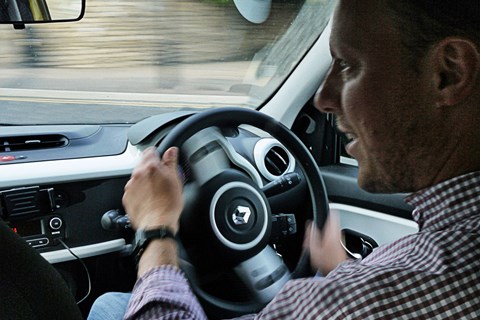
But then I drove it on the motorway, and found myself – like CAR’s James Taylor – too nervous to go anywhere near the speed limit in a sidewind – and not just because I’m used to that Range Rover.
By Ben Oliver
Month 10 running a Mk3 Twingo: how it compares to the Mk2
A friend popped round to visit recently, and instead of having a nice cup of tea and a chat was forced to stand around in the cold while I clambered in and out of his car, prodding the controls and distractedly opening and closing the boot.
That’s because he drives the previous-generation Twingo, the supposedly slightly-too-sensible-for-its-own-good Mk2 one. What better way to see just how brave and new the brave, new Twingo is than to compare it directly with its front-engined, front-drive predecessor?
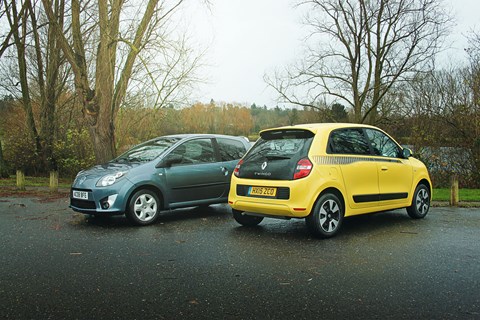
The bubble-packaged newer car’s actually only a few mil shorter than the old ’un but does have a much higher roofline, making it look a bit like it’s standing on tip-toe when they’re parked up together, and a longer wheelbase. That makes for more headroom than you’d ever need or want, and more kneeroom in the rear, but it’s the older car that feels the more practical of the two. Unusually, its rear seats can tumble and slide individually, and with no engine in the way the boot’s far deeper.
Twingo III strikes back with four neatly packaged doors to the old car’s cumbersome two (the Mk2 was only available as a 3dr), and a completely flat, surprisingly reasonable load space when the rear seat backs are folded. Plus it’s cleaner, less thirsty and a great deal lighter. Still, there’s a nagging sensation that the older car feels more well-rounded and usable than its more daring, creative successor. Which seems a shame, really.
By James Taylor
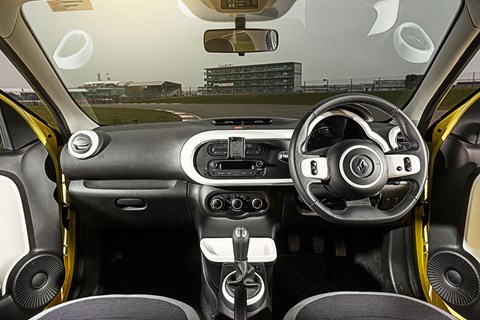
Month 9 running a Renault Twingo: looks like a bee, floats like a butterfly
The Twingo’s back at CAR Towers, and gave me a bit of a fright when I borrowed the keys for a recent motorway trek. Turns out it really doesn’t like crosswinds. A narrow footprint and a roof so high you barely need to duck to climb in made the Twingo more than a little flighty when the going got gusty, to the extent that it twice triggered the stability control system. A bit unnerving on the M1. Looks like a bee, floats like a butterfly. Or a kite.
By James Taylor
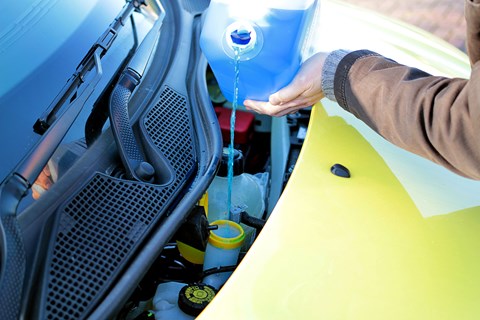
Month 8 running a Renault Twingo: refilling the screenwash is an epic challenge
Filling your windscreen washer bottle is straightforward on most cars, but not the Twingo. There’s no bonnet catch inside the car – instead, you have to remove a piece of plastic in the nose to reveal a lock; use the key to unlock and pop out two plastic levers; push the levers to release the bonnet, and then hitch it forwards to get at the fluid bottles. Why didn’t Renault just put a filler neck in the interior, and saved us the hassle?
By Mark Walton
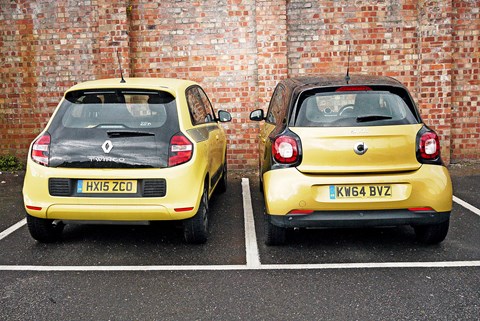
Month 7 running a Twingo: Smart or Renault?
The Twingo and Smart ForFour may be the same car under the skin, but that doesn’t make them the same car. For starters, our Twingo Play SCE costs £9995, whereas this posher ForFour Prime is £12,315. It’s hard to make like-for-like comparisons – both share the same three-cylinder engine and running gear, but their characters are as divergent as the trim levels.
They’re actually different sizes, for starters – the Smart is shorter by 100mm, believe it or not. I prefer the look of the Twingo, not least because of hidden rear-door handles that make it look like a racy sports coupe (in my mind). Inside, the Smart has more sophisticated trim, and a futuristic dashboard with (in this example) a big, optional touchscreen.
But the Twingo has a stripped-back, simple charm about it – it’s still a bit ‘Renault 4’, where the Smart feels ‘mini-Mercedes’. That extra kit means the Smart is heavier too, and a fraction slower – and in this world of wheezy 1.0-litre engines, every second counts. So I’ll stick to my bumble bee, and its rip-roaring 14.5sec 0-62mph time, thank you very much.
By Mark Walton
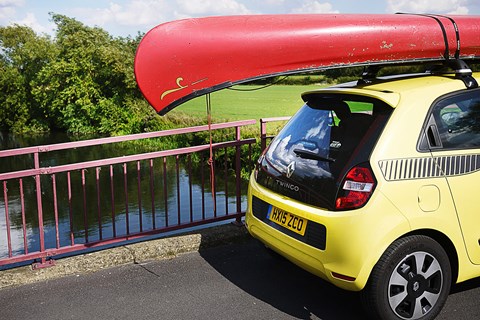
Month 6 running a Renault Twingo 1.0 SCe Play: three cylinders and a boat!
It played havoc with the aerodynamics. It felt like I’d attached a sail to the roof, or a parachute; as if at any moment it might lift the car like an empty plastic bag in a breeze, and swirl it into the air to get tangled in a streetlight. Directional stability was also affected, the steering wheel jinking left and right as the crosswinds grabbed a hold of us, like a toy car with a handle on the roof. I can see why Renault doesn’t offer a five-metre Canadian canoe as an option on the Twingo.
However, they do offer roof bars! True, the roof in question is as big as a hand towel, but just because it’s small doesn’t mean the titchy Renault can’t go on big, round-the-world adventures. Imagine: a glovebox full of exotic maps; the roof loaded high with camping equipment like an old Land Rover on safari; and the little three-cylinder engine groaning and wheezing with the effort. The Himalayas would be an entirely first-gear affair, but the Gobi Desert would be a piece of cake.
Sadly, without a six-month window in my diary and with half the world in some kind of horrific civil war, I couldn’t go on a round-the-world trip this time; but those roof bars kept staring at me in the Twingo brochure, whispering ‘Use me! Uuuusssse meeeeeee!’ So I decided to do what I always do whenever civilisation is threatened, society is crumbling and the world is sliding into geo-political disaster: I bugger off on my boat.
I’ve owned this canoe for over a decade now, and it comes out regularly each summer. It’s a five-metre-long Old Town Charles River, made out of a material called ‘Royalex’, which feels like washing-up-bowl plastic but is actually a fancy composite devised by UniRoyal in the 1960s. Light and strong and capable of recovering from dents, it was used in a Ford concept car in 1965, the pretty ‘Bordinat Cobra’. But it proved too expensive for big items, so it’s been mainly used for canoe hulls ever since – though I hear Royalex production has ceased now, because of the low volumes. Shame. When this one breaks, my next boat will have to be made of real washing-up bowl plastic… made from real washing-up bowls.
Anyway, the Renault roof bars cost £112 and they’re unlike any bars I’ve ever fitted before. They wrap around the roof and grip inside the door frame with the help of small pins, which locate in four corresponding holes (holes you’ll find in all Twingos, if you open the doors and look). Once tightened, the bars bear the cargo on big pads that sit on the edges of the roof – the instructions say they’re rated at 60kg total (including the aluminium bars). Bizarrely, the bars interfere with the door seals, making the rubber curl up at the tops of each door. These bars are definitely a temporary, get-the-job-done-and-then-take-them-off-again attachment – I imagine the doors would leak in a downpour. The bars also look ridiculous with nothing on them. Around 80cm across and just 70cm apart, they make the car look even more like a yellow shopping trolley, now with rails to push; but with the boat loaded up and strapped down, I thought the car looked truly magnificent. The Twingo is only 3.6 metres long, almost 1.5 metres shorter than its new, bright red accessory, but I thought it carried it off with a graceful pride.
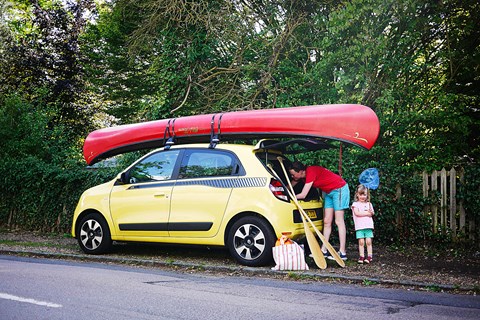
I’ve been on some long river adventures in the canoe, including paddling from Lincolnshire all the way to the Wash a few years ago; but this weekend it would be a short day-trip down a local river. So we headed for the water, and straight away the canoe on the roof made itself known. Apart from the rustling wind noise, and the feeling like the car might take off at any moment, there was also a marked dulling effect on the performance. With a kerbweight of just 865kg and a torque curve like a felled tree, the normally aspirated Twingo SCe 70 is the sort of car that’s very susceptible to weight changes. Empty the door pockets of sweet wrappers and you’ll feel it perk up; drive it after eating a full English breakfast and you’re buggered. So a 28kg canoe on the roof, plus the bars, the paddles, the picnic and the three of us, was bound to dent the already un-blistering 0-62mph time of almost 15 seconds.
Oh, and the turning circle. It also affected the turning circle. Because… well, look at it.
But we reached our river at a leisurely pace with no scary U-turns, and we had a wonderful day. If there’s one thing that can be said for the Twingo, it is a ‘feel good’ car. While it was conceived as a humdrum city car, it manages to rise above its boring domestic duties with a dose of cheeky charm. It’s got character, and I like that. The roof bars – and a canoe on the roof – can’t help but widen its appeal. And lengthen it quite a lot too.
By Mark Walton
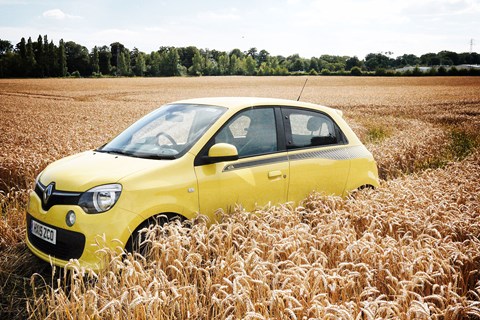
Month 5 running a Renault Twingo: small car, big character
The Twingo is turning out to be one of the most conspicuous cars I’ve ever driven. It was parked on the street near my home for a week while I was on holiday, and several members of the CAR team noticed it, looking neglected like an unwanted yellow puppy. They thought I’d died, or lost my keys or something. Funny – it’s just a city car, not a Lamborghini, but it definitely has a noticeable character, as well as colour. If you’re planning to do anything clandestine, choose a grey one.
By Mark Walton
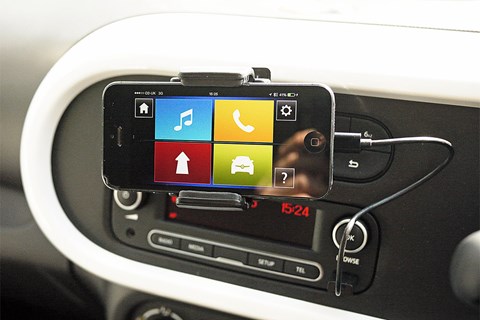
Month 4 running a 2015 Renault Twingo: on the phone
One of the several ways Renault saved money with the £10k Twingo was to give it a DIY touchscreen, in the form of a clip-on phone mount and a free ‘R&Go’ app. The app syncs with your car to do phonecalls and music and extras such as a digital rev counter. It’s not perfect – the mount position means your phone obscures the radio; and it makes for a fiddly sat-nav on the move. But to whinge about that feels a bit like flying Ryanair and then complaining when they don’t hand out hot towels – you get what you pay for.
By Mark Walton
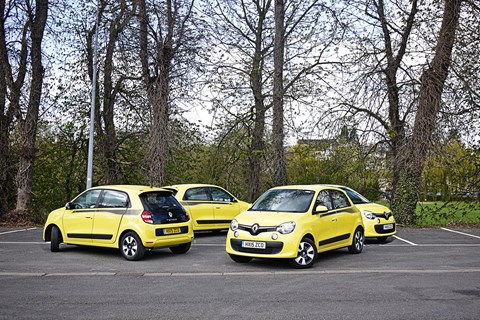
Month 3 running a 2015 Renault Twingo: turns on a dime
I like driving the Twingo. No, you can’t induce oversteer (I’ve tried) but the rear-engine, rear-drive configuration definitely lends it a different feel to your average city hatch. You can feel it settling on its outside-rear wheel when you throw it at a curve and get on the power.
Power! Ha! With just 69bhp on tap, overtaking is practically impossible unless it’s a tractor, or you swoop by an unsuspecting car on a long straight without pausing to give a polite warning. But again, there’s a pleasure to be had, maintaining momentum, and I get home from my daily commute feeling like I’ve thrashed it, which is satisfying. Fuel consumption is suffering from WLF (Walton Lead Foot).
The brakes are impressive. In fact they’re a little over-enthusiastic when you first drive it, grabbing when you breathe on them, but eventually you discover how powerful they are when you really stand on them. I’ve overtaken several cars into a roundabout, only to be re-taken again as I chug away on the way out.
Ah, but then there’s one thing – one huge and terrible flaw – that ultimately ruins the cheeky little Twingo. And that’s the steering. I’m not even talking about the horrible variable rack fitted to the turbo version – ours is the normally aspirated car, remember, with the linear steering. But… it’s electric, it has zero feel, and it is abominably slow. Four turns lock-to-lock! Driving round a multi-storey your arms are flailing about like you’re trying to swat a wasp. It’s like the steering wheel on one of those sit-on kiddie rides at the supermarket – a pink elephant on a rocker with flashing lights and a steering wheel that’s not connected to anything.
The handling, the brakes, all the pleasure of revving that little triple, all are ruined by this soulless, artificial, anaesthetised steering. It feels like it’s stuck in ‘city’ mode, designed to help grannies park; sadly there is no sharper, pointier setting.
So instead I have to content myself with the Twingo’s party trick: crank those front wheels all the way round and you can perform U-turns so tight the rear wheels are practically stationary, while the nose spins like a top. Sometimes, driving through town on a quiet night, I’ll do a 360-degree turn between the kerbs, just because.
By Mark Walton
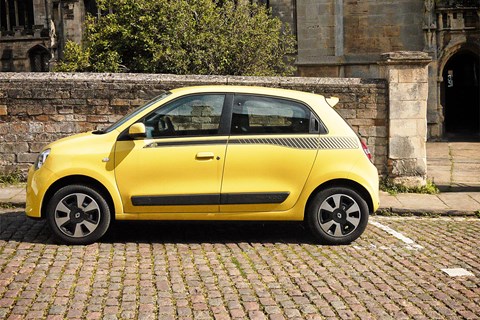
Month 2 running a Renault Twingo: Mark Walton on the city car's bumble bee paintjob
The Twingo appears to be under my charge, James having cleared off over the horizon in his Ginetta, and I like it a lot. True, ordering a bright yellow car is easier than living with one, and I’ve noticed a couple of pedestrians sniggering as I’ve driven past; but I’m over that now, and the car is affectionately known as The Bumblebee in our household. So what do I like? Its simplicity; its characterful phut-phut-phut tickover; the (upgraded) sound system; and the fact you can park it in a shoebox, should a parking space be unavailable.
By Mark Walton
Month 1 running a Renault Twingo Play SCe 70: the introduction to our long-term test
I really, really want to like this car. Inventively packaged city car concepts are ten-a-penny but how many actually make the jump from show floor to showroom? Hats off to Renault (with a little platform-sharing help from Smart/Mercedes) for putting its investment budget where its mouth is and making this new rear-engined, rear-drive kind of Twingo a reality.
Problem is, our Twingo vs VW Up twin-test threw up more than a few flaws in the French entry. Putting the drivetrain bits at the back hasn’t opened up quite as much interior space as you might think (for rear passengers at any rate), the boot’s compromised and there isn’t a bonus one in the front because it’s full of radiator. Throw in mushy controls and ponderous steering and we felt duty-bound to hand victory to the squarer (literally and metaphorically) front-engined, front-drive Up.
So while the Twingo might not be quite as spatially ingenious or dynamically engaging as we’d hoped, spending a few months in its company gives it a chance for its personality to make up for it. Perhaps that’s why I felt compelled to tick the ‘Inca Yellow’ box on the configurator. Yes, I’m to blame for the Tweety Pie-job. Theory was it would jump off the page nicely in photos and, with the black ‘Retro’ decals, maybe look a bit like a Renault 5 Turbo rally car if you squint slightly. I’m standing by it, no matter how much my colleagues point and laugh.
There’s a choice of two engines – I wanted the more powerful 898cc TCe 90 turbo because, well, I always want more power, but was advised against it by those who’ve driven it, and declare it laggy, truculent and blighted by odd-feeling variable-ratio steering. So the naturally aspirated, single-ratio-steered, 69bhp 999cc SCe it is. Trim-wise, I’ve picked the middling Play grade rather than the posher Dynamique because that’s the one Renault reckons will be the best-seller, and cars like this make more sense when they’re cheap-ish and relatively basic. So we’ve got Paris-friendly plastic wheel trims instead of alloys and have foregone the likes of lane departure warning and cruise control, but do get DAB, Bluetooth, speed limiter and height-adjust for the driver’s seat. The entry-level Expression gets most of the same kit but does without air-con; probably a stoop too far.
In SCe Play spec the Twingo should dip under £10k but I indulged in the premium audio option (£150), as there’s nothing worse than a long journey with a tinny stereo. Perhaps due to some logistical quirk, this comes as a package with electric mirrors, which seem oddly out of place in a car with pop-out rear windows. I also added storage nets under the rear seats (a snip at £20, channelling the spirit of the original Mini’s wicker baskets). Renault, with an eye on resale values, insisted we also add a leather steering wheel (£75) and rear-door storage pockets (only £20, but you’d think they’d be standard). All in, £10,585.
More on what it’s actually like to drive next time. The car has been temporarily snaffled by Mark Walton, who’s enjoying the umbrella-hooked-round-a-lamppost turning circle. The colour not so much.
By James Taylor
